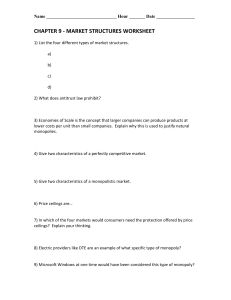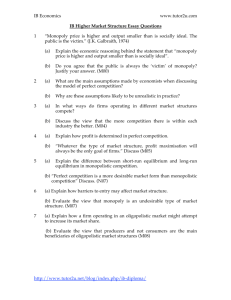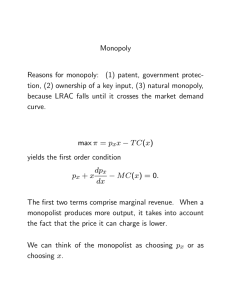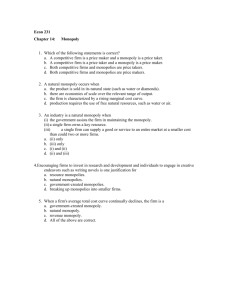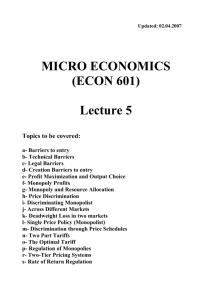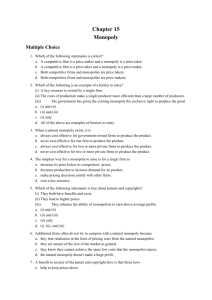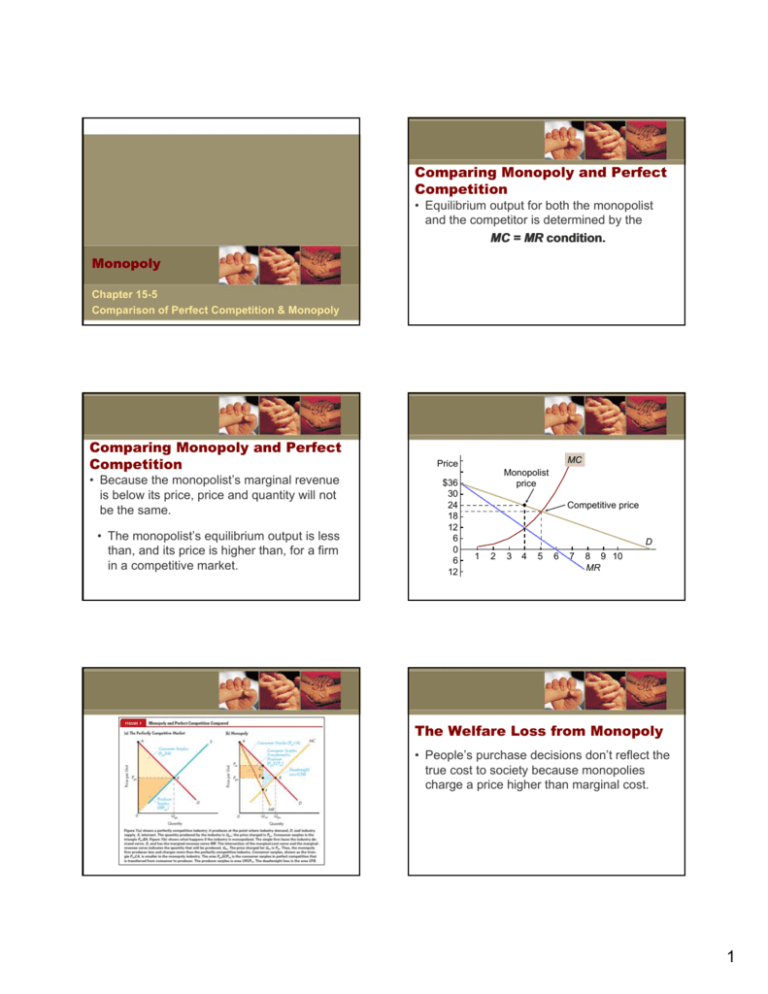
Comparing Monopoly and Perfect
Competition
• Equilibrium output for both the monopolist
and the competitor is determined by the
MC = MR condition.
Monopoly
Chapter 15-5
Comparison of Perfect Competition & Monopoly
Comparing Monopoly and Perfect
Competition
• Because the monopolist’s marginal revenue
is below its price, price and quantity will not
be the same.
• The monopolist’s equilibrium output is less
than, and its price is higher than, for a firm
in a competitive market.
MC
Price
$36
30
24
18
12
6
0
6
12
Monopolist
price
Competitive price
D
1
2
3
4
5
6
7
8 9 10
MR
The Welfare Loss from Monopoly
• People’s purchase decisions don’t reflect the
true cost to society because monopolies
charge a price higher than marginal cost.
1
The Welfare Loss from Monopoly
The Welfare Loss from Monopoly
• The marginal cost of increasing output is
lower than the marginal benefit of increasing
output.
• The welfare loss of a monopolist is
represented by the triangles B and D.
• The welfare loss is often called the
deadweight loss or welfare loss triangle.
The Welfare Loss from a
Monopoly
P
Price
• The welfare loss from a
monopoly is represented by
the triangles B and D
MC
MC
• The rectangle C is a transfer
of surplus from the consumer
to the monopolist
PM
C
PC
PM
PPC
D
C
D
B
B
A
0
McGraw-Hill/Irwin
QM
MR
QC
D
A
D
Quantity
MR
QM QPC
Q
• The area A represents the
opportunity cost of diverted
resources, which is not a loss
to society
© 2004 The McGraw-Hill Companies, Inc., All Rights Reserved.
Barriers to Entry
A Natural Monopoly Graph
• Natural Ability
• A firm is better at producing the good than anyone
else
Average
Cost
• One firm producing Q1 has average cost C1
• If two firms share the market, each produces
Q0.5 and has average cost C0.5
• Economies of Scale
• Natural monopoly is when a single firm can
produce at a lower cost than can two or more firms
• If three firms share the market, each
produces Q0.33 has average cost C0.33
C0.33
• Government-Created Monopolies
• Patents, licenses, and franchises
• If there were no barriers to entry, profitmaximizing firms would always compete
away monopoly profits
15-10
C0.5
C1
Q0.33
15-11
Q0.5
Q1
ATC
Q
15-12
2
A Natural Monopoly Graph, Profit
and Regulation
Average
Cost
• If there is government regulation and a
competitive solution where P = MC is
required, the monopolist produces QC
and charges PC, therefore earning a loss
PM
CM
CC
PC
Normative Views of Monopoly
• A natural monopolist produces QM and
charges PM, therefore earning a profit
Profits
Losses
MR
QM
D
QC
• Monopolies are unjust because they restrict freedom to
enter business
• Monopolies transfer income from “deserving” consumers
to “undeserving” monopolists
• Monopolies cause potential monopolists to waste
resources trying to get monopolies
• Rent-seeking activities
ATC
MC
Q
15-13
15-14
Government Policy and Monopoly:
AIDS Drugs
• A few companies have patents for AIDS drugs that enable
them to charge high prices because demand is inelastic
Policy Options
• Government regulation where price = marginal cost
benefits society, but discourages research
• Government purchase of the patents and allowing
anyone to produce the drugs so their price = marginal
cost. This is expensive for taxpayers.
15-15
3







